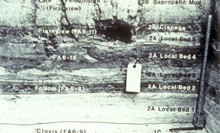Archaeological Context
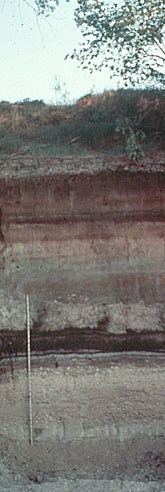
Significance of Site
Archaeological sites frequently have only one or two cultural levels and can display so little geological stratigraphy (layers of various sediments representing different periods of time) that the cultural levels are mixed and difficult to define. The Lubbock Lake Landmark exhibits a virtually complete cultural sequence from the Clovis Period to Historic times. These periods are easily distinguished due to the separation of sediment layers containing cultural material by sterile layers where sediment lacks artifacts.
Each layer represents a different time period, water regime, suite of plants and animals, group of peoples, and climate and environment covering the past 12,000 years of history and prehistory.
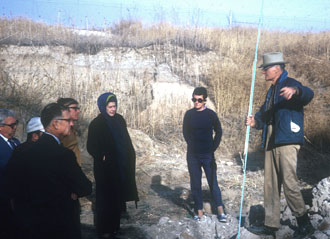
Cultural Sequence
The time of people in North America generally is divided into five cultural periods, all of which are represented at Lubbock Lake Landmark.
The first, the Paleoindian Period, is divided into:
- Clovis (11,500-11,000 years ago)
- Folsom (10,800-10,300 years ago)
- Plainview (10,000 years ago) and;
- Firstview (8,600 years ago)
Then follows the:
- Archaic Period (8,500-2000 years ago)
- Ceramic (2,000-500 years ago)
- Protohistoric (500-300 years ago) and;
- Historic (300 years ago to modern times)
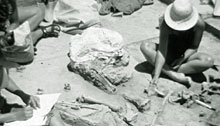
Paleoindian
Material from the Clovis Period has been found on a gravel bar of the once active stream in the ancient river valley. Excavations have uncovered the remains of several extinct animals: mammoth, two types of horse, camel, ancient bison, giant short-faced bear, and giant pampathere (armadillo-like animal). This material has been recovered from an area where secondary butchering of parts of carcasses took place and mammoth bones were broken to secure pieces to use or make into tools. Folsom and later Paleoindian peoples hunted and killed ancient bison around the ponds and marshes in the draw. Locations where bison were both killed and butchered are called kill/butchering locales.Archaic
The Archaic Period of the Southern High Plains is poorly understood. Several bone beds containing bison and pronghorn antelope remains have been found in the windblown and stream deposits of this stratum at the Landmark. A bison kill dating from the Early Archaic and a baking "oven" dating to the Middle Archaic have been discovered. This oven actually was a large oval pit that contained burned rock and ash. The absence of bone has led researchers to believe it was used for processing vegetal matter. Radiocarbon dating has determined the oven to be about 5,000 years old. Several Late Archaic camps have been uncovered. A camp generally is represented by hearths (campfires), scattered hearthstones, discarded tools, and scattered remains of small animals consumed as food.Ceramic
Broken Puebloan and Mogollon tradeware pottery have been found in the Ceramic levels. Archaeological features include camp sites with scattered stone tools, flakes (small segments of stone that are the result of tool making), broken bones, and hearths. Excavation of processing stations from this period have produced the remains of modern bison, coyote, wolf, and pronghorn antelope.Protohistoric
The Protohistoric Period is a transitional one. It extends from the time just prior to contact through first contact with Europeans. Spanish explorers were in the area during the later Protohistoric Period, but their presence had no detectable influence on the native cultures or archaeological remains. The Apaches are known to have been in the area from at least 1450 to the mid-1700s.Historic
The Historic Period represents the time of full contact with, and influence by, Europeans. Excavated Historic deposits indicate the presence of modern horse, as well as metal and glass. The Apache were displaced from the area by the Comanches who roamed the Southern High Plains from the mid-1700s to the 1870s. Information derived through excavation of sites from these time periods can be compared to historical records to provide a clearer understanding of the lifeways and population movements of these native peoples. Evidence of Anglo-American habitation has been found in the most recent archaeological deposits. Some of these artifacts reflect the use of this area by the buffalo hunters in the 1870s. Artifacts such as rifle cartridges, metal hardware, square nails, buttons, and a ginger beer bottle represent George Singer's store and home of the early 1880s. The Singer Store was the first commercial business for the area. Located at the edge of what was then called Long Lake and the crossing of two military trails, the store was built near the springs as a trading post for early settlers and cattle ranchers in the area. It was in operation from 1881-1886 when it burned down; the store was rebuilt further downstream. The Singer Store represents the founding of the community of Lubbock.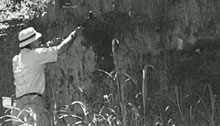
Stratigraphy
In addition to the cultural record, a geologic history is represented at the Landmark. The different sediments and buried soils indicate the local environment at various periods. The soils indicate numerous periods when the landscape was stable (no erosion or accumulation of sediment occurred). From these deposits, nearly 175 radiocarbon dates are available.
The bedrock of Lubbock Lake is the Blanco Formation. It is composed of an extensive deposit of lake sediments about 2 million years old. Above the Blanco Formation is the Blackwater Draw Formation, a sheet of wind-deposited sediment that covers most of the region. This deposit slowly accumulated between 1 million and 50,000 years ago. The Dune, in the northeastern section of Lubbock Lake, contains sediments and buried soils from at least 36,000 years ago. Yellowhouse Draw developed by 20,000 years ago, cutting through the Blackwater Draw Formation and into the Blanco Formation. By about 12,000 years before the present (B.P.), the draw had cut a meander (horseshoe bend) about 15 meters (49 feet) deep in the area of the Landmark.
Evidence points to a drying trend occurring at Lubbock Lake over the last 11,000 years. The geologic record begins with stream deposits, followed by lake sedimentation, and culminating between 6,500 and 4,500 years ago with the deposit of windblown sediments during a period of severe drought. After 4,500 years ago, the climate was much as it is now with minor alterations in the past 2,000 years.

